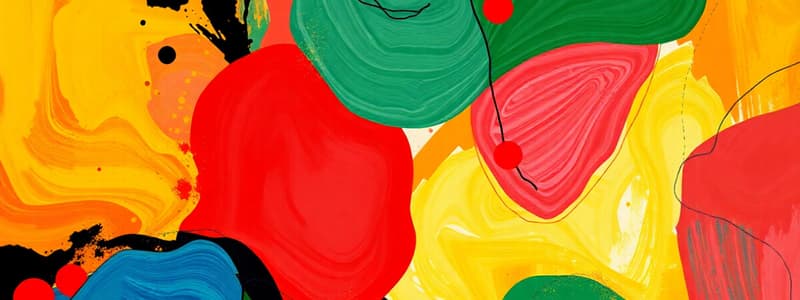Podcast
Questions and Answers
A patient presents with fever, chills, vomiting, and lower abdominal pain. Which additional assessment finding is most indicative of pyelonephritis rather than a simple lower urinary tract infection (UTI)?
A patient presents with fever, chills, vomiting, and lower abdominal pain. Which additional assessment finding is most indicative of pyelonephritis rather than a simple lower urinary tract infection (UTI)?
- Urinary frequency
- Cloudy urine
- Dysuria
- Costovertebral angle (CVA) tenderness (correct)
A patient is suspected of having cholecystitis. Which diagnostic finding is most indicative of cholecystitis?
A patient is suspected of having cholecystitis. Which diagnostic finding is most indicative of cholecystitis?
- Elevated serum lipase
- Positive Murphy's sign (correct)
- Positive leukocyte esterase on urinalysis
- Severe colicky pain in the flank
A patient presents with epigastric pain radiating to the back, along with nausea and vomiting. Lab results show a significantly elevated serum amylase and lipase (more than 3 times the upper limit of normal). Which condition is most likely?
A patient presents with epigastric pain radiating to the back, along with nausea and vomiting. Lab results show a significantly elevated serum amylase and lipase (more than 3 times the upper limit of normal). Which condition is most likely?
- Cholecystitis
- Nephrolithiasis
- Gastric ulcer
- Pancreatitis (correct)
A patient presents with severe colicky pain in the flank and hematuria. Which diagnostic test is the gold standard for identifying the underlying cause?
A patient presents with severe colicky pain in the flank and hematuria. Which diagnostic test is the gold standard for identifying the underlying cause?
A patient reports dyspepsia and is being evaluated for a possible gastric ulcer. Which diagnostic test would be most appropriate to confirm the diagnosis and rule out other conditions?
A patient reports dyspepsia and is being evaluated for a possible gastric ulcer. Which diagnostic test would be most appropriate to confirm the diagnosis and rule out other conditions?
A patient is diagnosed with Gastroesophageal Reflux Disease (GERD). What lifestyle modification is most important for managing their symptoms?
A patient is diagnosed with Gastroesophageal Reflux Disease (GERD). What lifestyle modification is most important for managing their symptoms?
An elderly patient is being evaluated for acute kidney injury (AKI). Which change in serum creatinine levels would meet the criteria for AKI?
An elderly patient is being evaluated for acute kidney injury (AKI). Which change in serum creatinine levels would meet the criteria for AKI?
A pregnant patient is experiencing hemorrhoids. What is a recommended initial treatment?
A pregnant patient is experiencing hemorrhoids. What is a recommended initial treatment?
A patient presents with fever, chills, CVA tenderness, and unilateral flank pain. What condition is most likely?
A patient presents with fever, chills, CVA tenderness, and unilateral flank pain. What condition is most likely?
A patient presents with bloating, distention, and guarding pain. They report decreased bowel movements and a feeling of a foreign body in the rectum. Which of the following is a potential red flag that requires further investigation?
A patient presents with bloating, distention, and guarding pain. They report decreased bowel movements and a feeling of a foreign body in the rectum. Which of the following is a potential red flag that requires further investigation?
A young male patient presents with low back pain, perineal pain, and a decreased urinary stream. He is afebrile. Which condition do you suspect?
A young male patient presents with low back pain, perineal pain, and a decreased urinary stream. He is afebrile. Which condition do you suspect?
Which finding in a patient presenting with a suspected hernia would be considered a medical emergency?
Which finding in a patient presenting with a suspected hernia would be considered a medical emergency?
A young male presents with acute onset of significant testicular pain. On examination, the testicle is elevated and the cremasteric reflex is absent. What condition is most likely?
A young male presents with acute onset of significant testicular pain. On examination, the testicle is elevated and the cremasteric reflex is absent. What condition is most likely?
During an evaluation for nausea and vomiting, what finding would be considered a red flag warranting further investigation?
During an evaluation for nausea and vomiting, what finding would be considered a red flag warranting further investigation?
An infant is diagnosed with a hydrocele. Which information is most important to provide to the parents?
An infant is diagnosed with a hydrocele. Which information is most important to provide to the parents?
A patient reports rectal bleeding. What characteristic of the blood suggests an upper gastrointestinal (GI) source?
A patient reports rectal bleeding. What characteristic of the blood suggests an upper gastrointestinal (GI) source?
What physical exam finding is most indicative of a varicocele?
What physical exam finding is most indicative of a varicocele?
A patient presents with nocturnal perianal itching. Which diagnostic test is most appropriate?
A patient presents with nocturnal perianal itching. Which diagnostic test is most appropriate?
Which of the following is a common symptom of a testicular cancer that warrants further investigation?
Which of the following is a common symptom of a testicular cancer that warrants further investigation?
A patient presents with acute onset of diarrhea and abdominal pain localized to the right lower quadrant (RLQ). On examination, there is RLQ tenderness, guarding, and rebound tenderness. Palpation of the left lower quadrant elicits pain in the RLQ. What test is being performed?
A patient presents with acute onset of diarrhea and abdominal pain localized to the right lower quadrant (RLQ). On examination, there is RLQ tenderness, guarding, and rebound tenderness. Palpation of the left lower quadrant elicits pain in the RLQ. What test is being performed?
Flashcards
Dysuria
Dysuria
Burning and pain with urination
Red Flags for Pyelonephritis
Red Flags for Pyelonephritis
Presence of fever, chills, vomiting, lower abdominal pain/back pain & CVA tenderness
UTI Prevention Tip
UTI Prevention Tip
Wipe front to back after urination or bowel movement.
Cholecystitis Pain
Cholecystitis Pain
Signup and view all the flashcards
Positive Murphy's sign
Positive Murphy's sign
Signup and view all the flashcards
Pancreatitis Pain
Pancreatitis Pain
Signup and view all the flashcards
Pancreatitis Lab Finding
Pancreatitis Lab Finding
Signup and view all the flashcards
Common Causes of Pancreatitis
Common Causes of Pancreatitis
Signup and view all the flashcards
Nephrolithiasis pain
Nephrolithiasis pain
Signup and view all the flashcards
Gastric ulcer treatment
Gastric ulcer treatment
Signup and view all the flashcards
GERD symptoms
GERD symptoms
Signup and view all the flashcards
Red flags in GERD
Red flags in GERD
Signup and view all the flashcards
Lifestyle modifications: GERD
Lifestyle modifications: GERD
Signup and view all the flashcards
Diagnosis of acute kidney injury
Diagnosis of acute kidney injury
Signup and view all the flashcards
Pregnant women and hemorrhoids
Pregnant women and hemorrhoids
Signup and view all the flashcards
Pyelonephritis Recognition
Pyelonephritis Recognition
Signup and view all the flashcards
Consitpation diagnostic
Consitpation diagnostic
Signup and view all the flashcards
Common Causes of Prostatitis
Common Causes of Prostatitis
Signup and view all the flashcards
Characteristics of prostate gland with prostatitis
Characteristics of prostate gland with prostatitis
Signup and view all the flashcards
Symptom of Syphilis
Symptom of Syphilis
Signup and view all the flashcards
Study Notes
Urinary Tract Infection
- The most common bacteria associated with UTIs is E. coli.
- Symptoms include urinary frequency, lower abdominal or back discomfort, burning and pain with urination (dysuria), cloudy or foul-smelling urine, and hematuria.
- Fever is rare in adults but common in children with upper UTIs.
- Red flags include fever, chills, vomiting, lower abdominal/back pain, and CVA tenderness, which may indicate pyelonephritis.
- Diagnosis of a UTI involves a urinalysis showing WBCs, positive leukocytes esterase, nitrites, and protein.
- First-line treatments are Nitrofurantoin (Macrobid), TMP-SMX (Bactrim), and Fosfomycin (Monurol).
- Health promotion: Instruct patients to wipe from front to back to prevent UTIs.
Cholecystitis
- Most cases are associated with the presence of gallstones.
- Patients may experience RUQ pain or epigastric pain that radiates to the right shoulder or subscapular area, mild fever, anorexia, nausea, and vomiting.
- Symptoms often occur after a large or fatty meal.
- A red flag is a positive Murphy's sign, where pain occurs when pressing the RUQ of the abdomen while the patient holds their breath.
- Diagnostics: Ultrasound is the first line; a HIDA scan is used if the ultrasound is negative.
- Elevated WBC count suggests infection/inflammation as well as elevated liver enzymes (AST, ALT) and bilirubin in some cases
- Treatment of severe attacks includes NPO, while mild cases require avoiding fatty foods.
- Can treat with Laparoscopic or open cholecystectomy within 72 hours of diagnosis.
Pancreatitis
- Characterized by the abrupt onset of deep epigastric pain, often radiating to the back, described as burning or shooting pain, accompanied by nausea, vomiting, sweating, and weakness, abdominal tenderness and distention, guarding, fever and tachycardia.
- Diagnostics involve leukocytosis and elevated serum amylase and lipase, with levels more than 3x the upper limit of normal within 24 hours.
- CT scans confirm the diagnosis and assess severity.
- Ultrasound evaluates gallstones or biliary obstruction.
- MRCP (Magnetic Resonance Cholangiopancreatography) is used for detailed biliary imaging.
- Treatment relies on resting the pancreas via NPO for 3 days, bed rest, NG suction in severe cases, meperidine (Demerol) for pain relief, and IV fluids and electrolyte management.
- Health promotion: Educate on how alcohol abuse and gallstones account for most cases in the US.
Nephrolithiasis/Urolithiasis
- Recognition: Severe colicky pain (renal colic) in the abdomen, flank, or groin along with blood in the urine.
- Most serious type of stone is staghorn due to large branching.
- Spiral CT is the gold standard for diagnostics, but remains expensive
- KUB x-ray will not identify uric stones, small stones, or stones over bony prominences
- Ultrasound is a cost-saving measure for pregnancy
- Treatment includes supportive care and surgery
- Education includes hydration
Gastric Ulcer
- Usually asymptomatic, but dyspepsia is the most common complaint; may be associated with reflux and N/V.
- Other symptoms are pain w/ eating, which may be dull, burning, or gnawing, iron deficiency anemia, and perforation, leading to a board-like abdomen with rebound tenderness.
- Diagnostics include upper endoscopy, double-contrast barium radiography of the upper GI system, and a urea breath test for H. pylori, which requires a 6-hour fast and no PPI use.
- Treatment: PPI for 8 weeks based on etiology.
- Sucralfate may be prescribed.
Gastroesophageal Reflux Disease (GERD)
- Can cause chronic sore throat, hoarseness, dysphagia, teeth erosion, heartburn (cardinal sign, pyrosis), regurgitation, lump in throat sensation, chest pain.
- Bilious vomiting and hematemesis are red flags in children.
- A complication from GERD is Barret esophagus
- Diagnostic approach is based on symptoms.
- An 8-week course of PPIs is a common treatment.
- Lifestyle modifications include avoiding caffeine, chocolate, tomatoes, and spicy foods, as well as weight control.
Acute Kidney Injury
- Characterized by abrupt onset within 48 hours, oliguria may be present, a rise in serum creatinine of >0.3mg/dL or an increase of >1.5 times baseline serum creatinine with reduction of urinary volume of <0.5mL/kg/hr for at least 6 hours.
Hemorrhoids
- Are most common in pregnant women
- Symptoms: constipation, increased venous pressure, bleeding, itching, and pain with defecation.
- Anemia and colon cancer could be red flags
- Treatment includes: Preparation H, fiber, stool softeners, avoiding prolonged sitting, avoiding straining, sitz baths and surgery (rubber band ligation)
Pyelonephritis
- Involves fever with high chills, CVA tenderness, unilateral flank pain, N/V, headache, delirium, and dysuria, frequency, and urgency when urinating.
- Delirium, AKI, sepsis, and renal scarring are red flags.
- Diagnostics: Urinalysis with culture and sensitivity (C&S) and CBC (leukocytosis).
Constipation
- Results in bloating/distention, guarding pain, foreign body feeling in rectum, decreased bowel movements, rectal inflammation
- Hemorrhoids, obstruction, cancer, and anticholinergic medications are red flags.
- Diagnostics include physical exam, DRE, occult blood test, and TSH
- Treatment involves MiraLAX/fiber, stool softeners, hydration, Senakot (stimulates bowel muscles), and Linzess (draws water to bowels).
Prostatitis
- Recognition: E. coli is more common in those >35 years old, while gonorrhea/chlamydia is more common for those <35 years old.
- Symptoms include low back pain, perineal pain including the scrotum, testes, and penis, and a decreased urinary stream secondary to urinary retention.
- DRE: Gentle prostate exam should be performed only if it's done.
- The prostate will be extremely tender, boggy, and possibly warm.
- UA (large WBCs, hematuria) and urine C&S, repeat 4-6 weeks after treatment initiated.
-
35yrs olds should take Ciprofloxacin or Levaquin (educate about risk of tendon rupture) for 4-6 weeks
- <35yrs olds should treat for gonorrhea and chlamydia
- Administer antipyretics, stool softener, sitz bath.
- Refer to ED if septic or toxic
Hernia
- Recognize inguinal hernia via physical exam and CT of the abdomen, pelvis
- Push it back in, surgery is an option, education on referrals and follow up
- Red Flags: blockage or a strangulated hernia- a medical emergency
Epididymitis
- <35 years: gonorrhea & chlamydia
-
35 years: Enterobacteriaceae (E. coli)
- If testicular torsion is suspected, do not delay treatment to obtain imaging
Studying That Suits You
Use AI to generate personalized quizzes and flashcards to suit your learning preferences.



